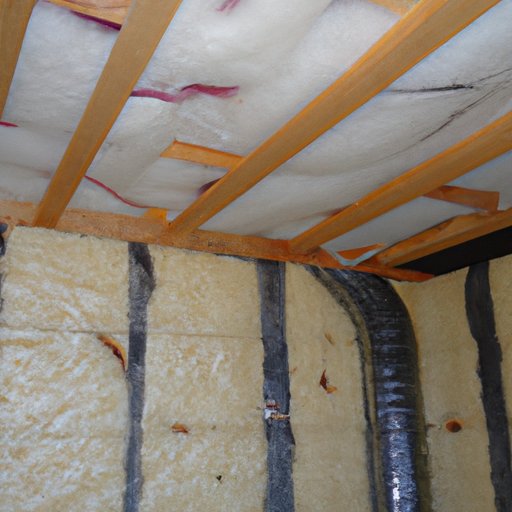Introduction
Insulating your home is a great way to improve energy efficiency and save money on energy bills. But what is insulation exactly and how does it work? In this article, we’ll explore the science behind insulation, investigate the different types available, examine the benefits of proper insulation, and outline the steps for installing insulation. We’ll also analyze the cost-effectiveness of insulation so you can make an informed decision about whether or not it’s worth investing in.
Definition of Insulation
Insulation is a material that is used to slow down the flow of heat, either from the inside of a building to the outside or vice versa. It’s usually made of materials like fiberglass, cellulose, or spray foam, and is installed in walls, attics, and other areas to help keep homes and buildings more comfortable year-round.
Explaining the Science Behind Insulation
Insulation works by preventing heat transfer. Heat transfer is the process by which heat moves from one area to another. There are three main ways that heat can transfer: conduction, convection, and radiation. Conduction occurs when heat passes through a solid material, such as a wall or window. Convection is the movement of heat through liquids or gases, and radiation is the transfer of heat through electromagnetic waves.
What is R-Value and Why is it Important?
The effectiveness of insulation is measured by its “R-value”. The higher the R-value, the better the insulation is at preventing heat transfer. According to the U.S. Department of Energy, “the R-value of insulation indicates the resistance to heat flow. The higher the R-value, the greater the insulating power.” For example, if you have an attic with an R-value of 10, it means that it will take 10 times longer for the heat to pass through the insulation than it would without any insulation.

Investigating Different Types of Insulation
There are several different types of insulation available, each with its own unique properties. Here’s a look at some of the most common types of insulation:
Fiberglass
Fiberglass insulation is one of the most popular types of insulation because it’s relatively inexpensive and easy to install. It’s made from strands of glass that are spun into a blanket-like material. It’s commonly used in walls and attics, and has an R-value of 2.9-3.8 per inch.
Cellulose
Cellulose insulation is made from recycled newspaper and other paper products. It’s treated with fire retardants and insecticides to help protect against fire and insects. It has an R-value of 3.7-4.3 per inch and is often used in attics and walls.
Spray Foam
Spray foam insulation is a type of insulation that comes in a spray can and expands when applied. It has an R-value of 6-7 per inch and is commonly used in attics, walls, and floors. It’s more expensive than fiberglass and cellulose but provides better insulation.

Examining the Benefits of Proper Insulation
Properly insulating your home can provide a number of benefits, including:
Energy Savings
By preventing heat transfer, insulation helps to keep your home cool in the summer and warm in the winter. This can lead to significant energy savings over time. According to the U.S. Department of Energy, “adding insulation to your home is one of the best investments you can make to reduce your energy bills.”
Increased Comfort
Insulation helps to keep your home comfortable throughout the year. During the summer, it will help keep your home cooler and during the winter, it will help keep it warmer. It can also help reduce drafts, which can make a room feel more comfortable.
Reduced Noise
Insulation can also help to reduce noise from outside sources. The insulation acts as a barrier between the interior of your home and the outside world, helping to reduce the amount of noise that enters the home.

Outlining the Steps for Installing Insulation
Installing insulation is a fairly straightforward process, but it’s important to follow the steps below to ensure that it’s done correctly:
Selecting the Right Type of Insulation
The first step is to select the right type of insulation for your needs. Consider factors like R-value, cost, and ease of installation when making your selection.
Preparing the Area
Once you’ve selected the type of insulation, the next step is to prepare the area where the insulation will be installed. This includes removing any existing insulation and cleaning the area.
Measuring and Cutting
The next step is to measure and cut the insulation to fit the space. Make sure to wear protective gear when handling insulation to avoid skin irritation.
Installing the Insulation
Once the insulation is cut to size, the next step is to install it. Be sure to follow the manufacturer’s instructions carefully to ensure that the insulation is installed properly.
Analyzing the Cost-Effectiveness of Insulation
Installing insulation can be a cost-effective way to improve the energy efficiency of your home. Here are a few factors that you should consider when evaluating the cost-effectiveness of insulation:
Calculating ROI
The return on investment (ROI) for insulation varies depending on the type of insulation and the area where it’s being installed. Generally speaking, you can expect to see a return on your investment within two to five years.
Understanding Tax Credits
In addition to potential energy savings, installing insulation may also qualify you for tax credits. Be sure to check with your local government to see if you qualify for any incentives.
Conclusion
Insulating your home can be an effective way to save energy, reduce noise, and increase comfort. The key to getting the most out of insulation is understanding how it works, selecting the right type of insulation, and installing it properly. By following these steps, you can ensure that your insulation will be cost-effective and provide you with the desired results.
(Note: Is this article not meeting your expectations? Do you have knowledge or insights to share? Unlock new opportunities and expand your reach by joining our authors team. Click Registration to join us and share your expertise with our readers.)
